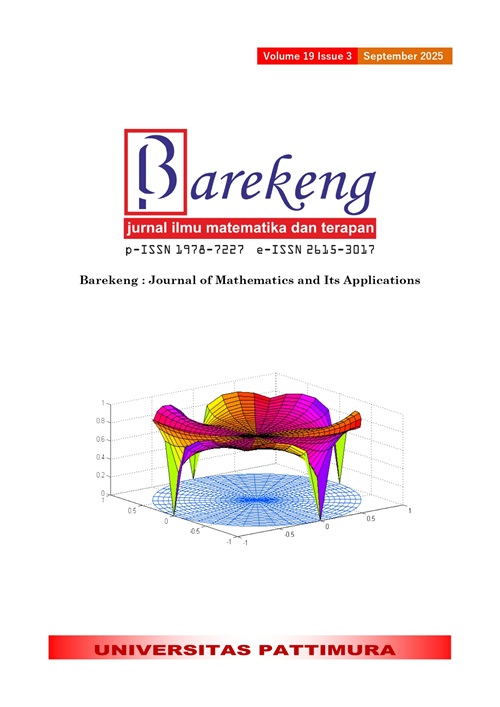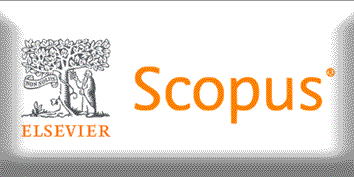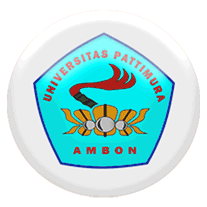COMPARATIVE ANALYSIS OF MACHINE LEARNING METHODS IN CLASSIFYING THE QUALITY OF PALU SHALLOTS
Abstract
This study conducts a comparative analysis of various machine learning methods for classifying the quality of Palu shallots based on the Indonesian National Standard (SNI). The dataset consists of 1,500 samples of Palu shallots, each characterized by 10 key features, including size, color, texture, and moisture content. Five machine learning models—Naïve Bayes, Decision Tree, Random Forest, Support Vector Machine (SVM), and Logistic Regression—were evaluated using accuracy, precision, recall, and F1 score as performance metrics. The results indicate that Random Forest achieved the best performance with an accuracy of 95.4%, followed by Decision Tree (90.7%) and SVM (90.2%). Random Forest also excelled in precision (93.6%) and F1 Score (93.5%), making it the most reliable model for shallot quality classification. Meanwhile, SVM demonstrated a good balance between recall and precision, making it a strong alternative. Implementing machine learning models has the potential to enhance the efficiency and accuracy of agricultural product quality assurance. The findings of this study provide valuable insights for farmers, agribusiness practitioners, and researchers adopting artificial intelligence technology for more precise and efficient agricultural quality assessment.
Downloads
References
S. Musdalifah, D. Lusiyanti, and A. Sahari, “CLUSTERING THE QUALITY OF PALU SHALLOT (ALLIUM ASCALONIUM L.) USING THE KOHONEN ALGORITHM,” 2023, doi: https://doi.org/10.1063/5.0133333.
D. Lusiyanti, S. Musdalifah, A. Sahari, and Y. Darmawanti, “RANCANG BANGUN SISTEM CLUSTERING KUALITAS BAWANG MERAH PALU (ALLIUMASCALONIUM L.) MENGGUNAKAN ALGORITMA KOHONEN,” J. Ilm. Mat. Dan Terap., vol. 19, no. 1, pp. 103–110, 2022, doi: https://doi.org/10.22487/2540766X.2022.v19.i1.15940.
Y. A. Pradana, L. P. Dewi, S. Muthiah, Y. Setyawati, F. R. S. Prakoeswa, and I. Untari, “DETEKSI KUALITAS BAWANG MERAH DENGAN CIRCULARITY IMAGE PRO-CESSING,” J. Keilmuan Dan Keislam., pp. 19–28, 2023, doi: https://doi.org/10.23917/jkk.v3i1.175.
A. K. Mutia, Y. A. Purwanto, and L. Pujantoro, “PERUBAHAN KUALITAS BAWANG MERAH (Allium Ascalonicum L.) SELAMA PENYIMPANAN PADA TINGKAT KADAR AIR DAN SUHU YANG BERBEDA ((Allium ascalonicum l.) During Storage at Different Temperature and Water Content),” J. Penelit. Pascapanen Pertan., vol. 11, p. 108, Jan. 2017, doi: https://doi.org/10.21082/jpasca.v11n2.2014.108-115.
E. Hossain, M. F. Hossain, and M. A. Rahaman, “A COLOR AND TEXTURE BASED APPROACH FOR THE DETECTION AND CLASSIFICATION OF PLANT LEAF DISEASE USING KNN CLASSIFIER,” in 2019 International Conference on Electrical, Computer and Communication Engineering (ECCE), 2019, pp. 1–6. doi: https://doi.org/10.1109/ECACE.2019.8679247.
Z. H. Kok, A. R. Mohamed Shariff, M. S. M. Alfatni, and S. Khairunniza-Bejo, “SUPPORT VECTOR MACHINE IN PRECISION AGRICULTURE: A REVIEW,” Comput. Electron. Agric., vol. 191, p. 106546, 2021, doi: https://doi.org/10.1016/j.compag.2021.106546.
N. Lestari, I. Indahwati, E. Erfiani, and E. Julianti, “A COMPARISON OF ARTIFICIAL NEURAL NETWORK AND NAIVE BAYES CLASSIFICATION USING UNBALANCED DATA HANDLING,” BAREKENG J. Ilmu Mat. dan Terap., vol. 17, no. 3 SE-Articles, Sep. 2023, doi: https://doi.org/10.30598/barekengvol17iss3pp1585-1594.
D. Singh and B. Singh, “FEATURE WISE NORMALIZATION: AN EFFECTIVE WAY OF NORMALIZING DATA,” Pattern Recognit., vol. 122, p. 108307, 2022, doi: https://doi.org/10.1016/j.patcog.2021.108307.
J. M. Johnson and T. M. Khoshgoftaar, “SURVEY ON DEEP LEARNING WITH CLASS IMBALANCE,” J. Big Data, vol. 6, no. 1, p. 27, 2019, doi: https://doi.org/10.1186/s40537-019-0192-5
D. Mustafa Abdullah and A. Mohsin Abdulazeez, “MACHINE LEARNING APPLICATIONS BASED ON SVM CLASSIFICATION A REVIEW,” Qubahan Acad. J., vol. 1, no. 2 SE-Articles, pp. 81–90, Apr. 2021, doi: https://doi.org/10.48161/qaj.v1n2a50.
B. Pes, “Ensemble Feature Selection For High-Dimensional Data: A Stability Analysis Across Multiple Domains,” Neural Comput. Appl., vol. 32, no. 10, pp. 5951–5973, 2020, doi: https://doi.org/10.1007/s00521-019-04082-3.
Y. Aksu, D. J. Miller, G. Kesidis, and Q. X. Yang, “MARGIN-MAXIMIZING FEATURE ELIMINATION METHODS FOR LINEAR AND NONLINEAR KERNEL-BASED DISCRIMINANT FUNCTIONS,” IEEE Trans. Neural Networks, vol. 21, no. 5, pp. 701–717, 2010, doi: https://doi.org/10.1109/TNN.2010.2041069.
C. Oganis, S. Musdalifah, and D. Lusiyanti, “KLASIFIKASI STATUS GIZI IBU HAMIL UNTUK MENGIDENTIFIKASI BAYI BERAT LAHIR RENDAH (BBLR) MENGGUNAKAN METODE SUPPORT VECTOR MACHINE (SVM) (STUDI KASUS DI PUSKESMAS LABUAN),” J. Ilm. Mat. Dan Terap., vol. 14, no. 2, pp. 144–151, 2017, doi: https://doi.org/10.22487/2540766X.2017.v14.i2.9017.
H. Li and Y. Ping, “RECENT ADVANCES IN SUPPORT VECTOR CLUSTERING: THEORY AND APPLICATIONS,” Int. J. Pattern Recognit. Artif. Intell., vol. 29, Oct. 2014, doi: https://doi.org/10.1142/S0218001415500020.
T. Naing and A. N. Oo, “DECISION TREE MODELS FOR MEDICAL DIAGNOSIS,” Int. J. Trend Sci. Res. Dev., vol. Volume-3, no. Issue-3, pp. 1697–1699, 2019, doi: https://doi.org/10.31142/ijtsrd23510.
B. P. Battula, K. Krishna, and T. Kim, “An Efficient Approach for Knowledge Discovery in Decision Trees Using Inter Quartile Range Transform,” Int. J. Control Autom., vol. 8, no. 7, pp. 325–334, 2015, doi: 10.14257/ijca.2015.8.7.32.
A. Purwanto, B. Sartono, and K. A. Notodiputro, “A COMPARISON OF RANDOM FOREST AND DOUBLE RANDOM FOREST: DROPOUT RATES OF MADRASAH STUDENTS IN INDONESIA,” BAREKENG J. Ilmu Mat. dan Terap., vol. 19, no. 1 SE-Articles, Jan. 2025, doi: https://doi.org/10.30598/barekengvol19iss1pp227-236.
S. Tangirala, “EVALUATING THE IMPACT OF GINI INDEX AND INFORMATION GAIN ON CLASSIFICATION USING DECISION TREE CLASSIFIER ALGORITHM*,” Int. J. Adv. Comput. Sci. Appl., vol. 11, no. 2, 2020, doi: https://doi.org/10.14569/IJACSA.2020.0110277.
A. Nugroho and A. Abdullah, “PERFORMANCE ANALYSIS OF RANDOM FOREST USING ATTRIBUTE NORMALIZATION,” Sistemasi, vol. 11, no. 1, p. 186, 2022, doi: https://doi.org/10.32520/stmsi.v11i1.16811.
S. Wang, “DIABETES PREDICTION USING RANDOM FOREST IN HEALTHCARE,” Highlights Sci. Eng. Technol., vol. 92, pp. 210–217, 2024, doi: https://doi.org/10.54097/5ndh9a05
“MATHEMATICAL JUSTIFICATION ON THE ORIGIN OF THE SIGMOID IN LOGISTIC REGRESSION,” 2022, doi: 10.57030/23364890.cemj.30.4.135.
J. Liu, J. Cui, and C. Chen, “ONLINE EFFICIENT SECURE LOGISTIC REGRESSION BASED ON FUNCTION SECRET SHARING,” 2023, doi: https://doi.org/10.1145/3583780.3614998.
A. Al Imran, A. Rahman, H. Kabir, and S. Rahim, “THE IMPACT OF FEATURE SELECTION TECHNIQUES ON THE PERFORMANCE OF PREDICTING PARKINSON’S DISEASE,” Int. J. Inf. Technol. Comput. Sci., vol. 10, no. 11, pp. 14–29, 2018, doi: https://doi.org/10.5815/ijitcs.2018.11.02.
Y. Wang, “ANALYSIS OF THE EVOLUTION OF MODERN CHINESE HISTORY BASED ON DATA MINING,” Appl. Math. Nonlinear Sci., vol. 9, no. 1, 2023, doi: https://doi.org/10.2478/amns.2023.2.00428.
A. Wahid, F. Azim, and F. Firdausi, “APPLICATION OF DATA MINING TO CLASSIFY RECEIVING SOCIAL ASSISTANCE USING THE NAÏVE BAYES METHOD,” vol. 1, no. 2, pp. 62–66, 2023, doi: https://doi.org/10.31967/inside.v1i2.881.
S. Shang, “AN IMPROVED TEXT SENTIMENT ANALYSIS ALGORITHM BASED ON TF-GINI,” 2018, doi: https://doi.org/10.23940/ijpe.18.09.p8.20082014.
A. Luque, A. Carrasco, A. Martín, and A. de las Heras, “THE IMPACT OF CLASS IMBALANCE IN CLASSIFICATION PERFORMANCE METRICS BASED ON THE BINARY CONFUSION MATRIX,” Pattern Recognit., vol. 91, pp. 216–231, 2019, doi: https://doi.org/10.1016/j.patcog.2019.02.023.
D. Ballabio, F. Grisoni, F. Grisoni, and R. Todeschini, “MULTIVARIATE COMPARISON OF CLASSIFICATION PERFORMANCE MEASURES,” Chemom. Intell. Lab. Syst., vol. 174, pp. 33–44, 2017, doi: https://doi.org/10.1016/j.chemolab.2017.12.004.
Copyright (c) 2025 Desy Lusiyanti, Selvy Musdalifah, Agusman Sahari, Iman Al Fajri

This work is licensed under a Creative Commons Attribution-ShareAlike 4.0 International License.
Authors who publish with this Journal agree to the following terms:
- Author retain copyright and grant the journal right of first publication with the work simultaneously licensed under a creative commons attribution license that allow others to share the work within an acknowledgement of the work’s authorship and initial publication of this journal.
- Authors are able to enter into separate, additional contractual arrangement for the non-exclusive distribution of the journal’s published version of the work (e.g. acknowledgement of its initial publication in this journal).
- Authors are permitted and encouraged to post their work online (e.g. in institutional repositories or on their websites) prior to and during the submission process, as it can lead to productive exchanges, as well as earlier and greater citation of published works.






1.gif)



